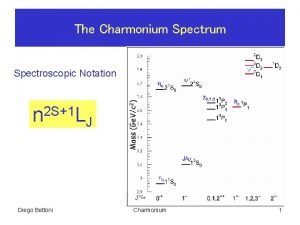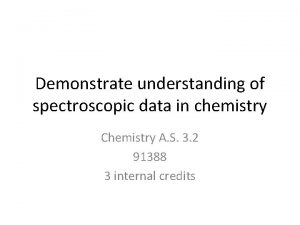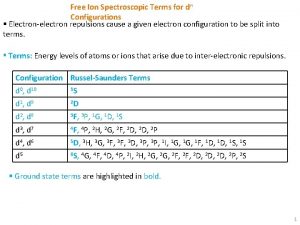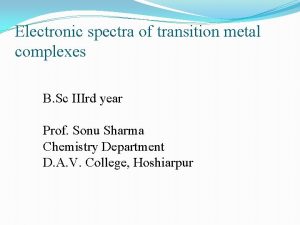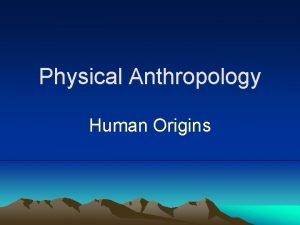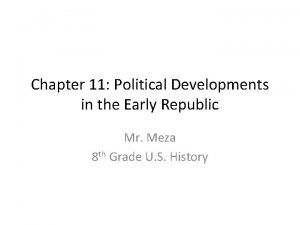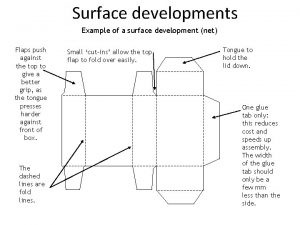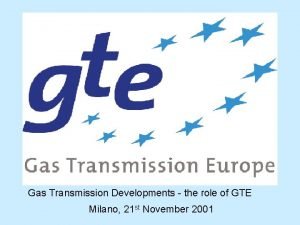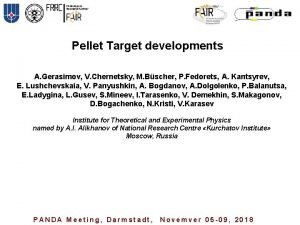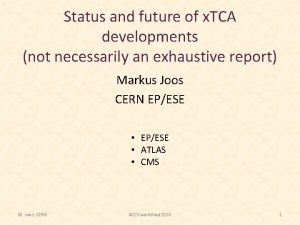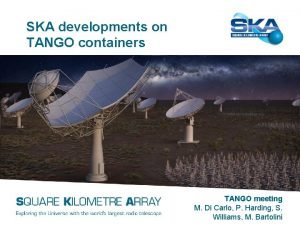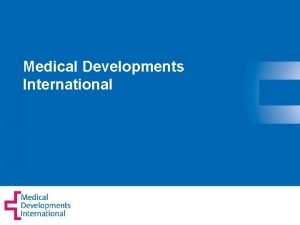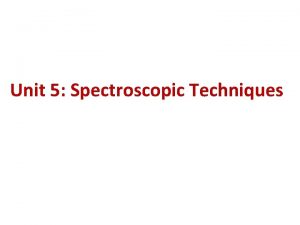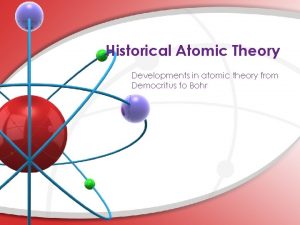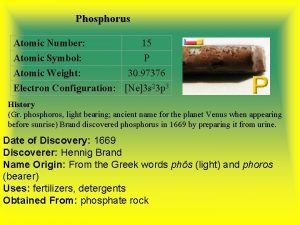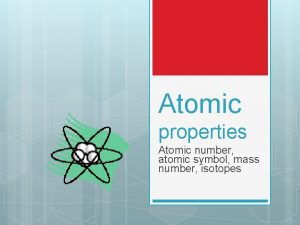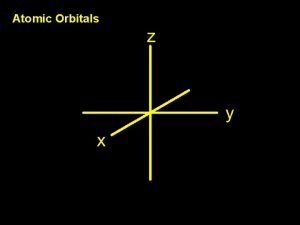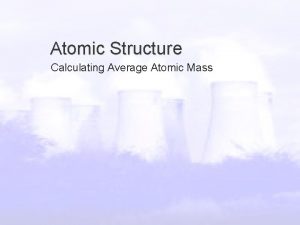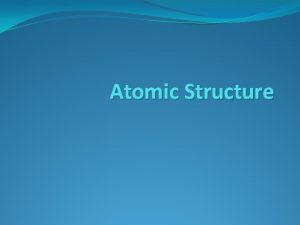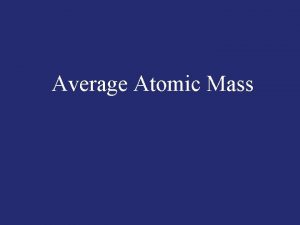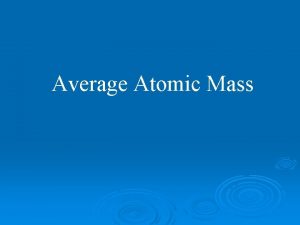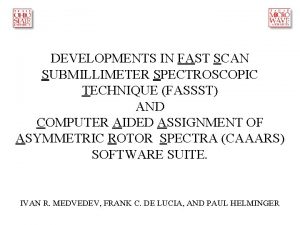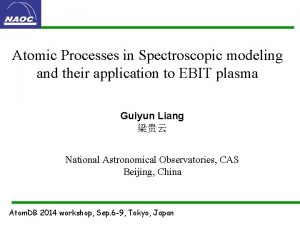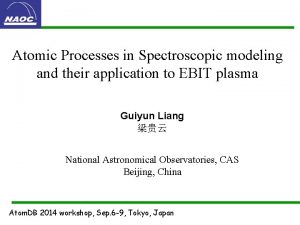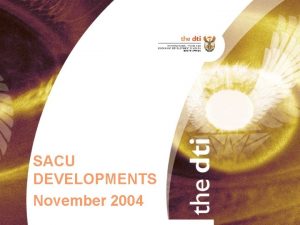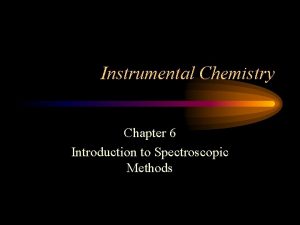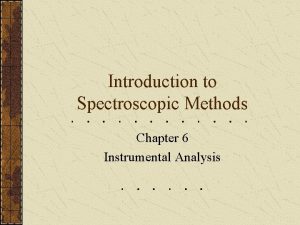New Developments in Atomic Spectroscopic Methods with a







![LOQ Requirements for the 4 priority metals Cadmium LOQ [ng/l] (30 % of lowest LOQ Requirements for the 4 priority metals Cadmium LOQ [ng/l] (30 % of lowest](https://slidetodoc.com/presentation_image/6f04add98ad12acabe4e9ba630ea4a75/image-8.jpg)





























![Uranium in German Drinking Waters Name of the Study Max. Value [µg/l] 26, 2 Uranium in German Drinking Waters Name of the Study Max. Value [µg/l] 26, 2](https://slidetodoc.com/presentation_image/6f04add98ad12acabe4e9ba630ea4a75/image-38.jpg)




- Slides: 42

New Developments in Atomic Spectroscopic Methods - with a Focus on Standardisation- Dr Ulrich Borchers PRIMER CONGRESO INTERNACIONAL DE DOCENCIA E INVESTIGACIÓN EN QUÍMICA México, 27 th - 29 th October 2010

Dr Ulrich Borchers Food Chemist Head of Dept. Water Quality n Education - Exam in Food Chemistry (Technical University Braunschweig) - Ph. D Thesis: „Turnover of Nitrogen in Soil and Groundwater“ (Institute for Microbiology at TU Braunschweig) n Projects / memberships - Interlaboratory trials, Education of sampling personnel - Chairman CEN Technical committee „Water quality“ - Member of the DIN main committee water analysis n Main activities - Chemical and microbiological analysis of water - Assessment of products for water treatment - Sampling techniques and strategies - Education of health authorities staff - Technical CEO IWW Nord 2

Topics n Performance Requirements n Atomic Absorption Spectrometry - Routine methods and recent developments - Revision of existing Hg methods (ISO/DIS 12846) n Atomic Fluorescence Spectrometry - Mercury - Hydride Forming Elements n ICP-OES - What’s new in ISO 11885 (2009) n ICP-MS - Is ISO 17294 still state-of-the-play? n Summary and Outlook 3

Heavy Metals to be Monitored (WFD) DECISION 2455/2001/EC List of Priority Substances (33) n Priority Substances - Present a significant risk to or via the aquatic environment n Priority Hazardous Substances - Subset of priority substances, which are toxic, persistent, liable to bioaccumulate or give rise to equivalent level of concern 4

Priority Substances/Other Pollutants Priority Hazardous Substances Priority Substances Other Specific Pollutants Anthracene Alachlor DDT / p, p‘-DDT Pentabromodiphenylether Atrazin Aldrin Benzene Dieldrin C 10 -C 13 -Chloroalkanes Chlorpyrifos Endrin Endosulfan Chlorfenvinphos Isodrin Hexachlorobenzene 1, 2 -Dichloroethane Carbontetrachloride Hexachlorobutadiene Dichloromethane Tetrachloroethylene Hexachlorocyclohexane Di(2 -ethylhexyl)phthalate (DEHP) Trichloroethylene Cadmium and its compounds Mercury and its compounds Diuron Nonylphenol Fluoranthene Pentachlorobenzene Isoproturon Polyaromatic Hydrocarbons (PAH) Tributyltin compounds Lead and its compounds Naphthalene Nickel and its compounds Octylphenol Pentachlorophenol Simazine Trichlorobenzenes Trichloromethane Trifluralin 5

Requirements: QA/QC Commission Directive …. laying down, pursuant to Directive 2000/60/EC of the European Parliament and of the Council, technical specifications for chemical analysis and monitoring of water status n Provision of data of proper scientific quality - Basis for programme of measures n Comparability of monitoring results across Europe - Implementation of common principles and harmonised procedures for chemical monitoring 6

Commission Directive – Draft Proposal n Standardised methods and other validated method are to be used - Any method provided it is properly validated and meets certain performance criteria may be applied n Requirements on analytical methods - Validation according to EN ISO 17025 - Limit of Quantification § 30 % of relevant EQS - Relative target Uncertainty § 50 % n If there is no EQS or if existing methods do not meet the criteria - „Best available technique“ 7
![LOQ Requirements for the 4 priority metals Cadmium LOQ ngl 30 of lowest LOQ Requirements for the 4 priority metals Cadmium LOQ [ng/l] (30 % of lowest](https://slidetodoc.com/presentation_image/6f04add98ad12acabe4e9ba630ea4a75/image-8.jpg)
LOQ Requirements for the 4 priority metals Cadmium LOQ [ng/l] (30 % of lowest EQS) AAS ICP-OES ICP-MS 24 (IWW = 30 ng/l) Mercury 15 (AFS also OK) Lead 2160 Nickel 6000 8

Topics n Performance Requirements for WFD monitoring n Atomic Absorption Spectrometry - Routine methods and recent developments - Revision of existing Hg methods (ISO TC 147/SC 2/WG 61) n Atomic Fluorescence Spectrometry - Mercury - Hydride Forming Elements (ISO TC 147/SC 2/WG 53) n ICP-OES - What’s new in BS EN ISO 11885 (2009) n ICP-MS - short outlook to relevant methods for DW n Summary and Outlook 9

AAS in Water Analysis (1) The Initiation! n May 1952: First idea on F-AAS by Sir Alan Walsh (born 1916 in England, BSc/MSc in Manchester) n 1961: first publication on the „graphite tube“ by Boris L´vov n 1962: first commercial F-AAS system 10

Standardisation of Methods: Co-operation BSI with CEN and ISO n BSI Committee EH/3 „Water analysis“ - British “mirror committee” of the respective § European and § International committee CEN TC 230 „Water Analysis“ ISO TC 147 „Water Quality “ 11

Existing Set of Methods n Nearly complete set of BS or BS EN (ISO) methods for relevant metals in water - Lots of single element standards - But also horizontal standards § e. g. BS EN ISO 15586 (22 elements by GF-AAS) n Complete list see: - http: //www. bsi-global. com/en/Search. Results/? q=atomic+absorption n Recent revisions: - Flow systems for HG (instead of batch systems) More general description of light sources More performance based approaches Alternatives for digestion techniques § Separate standards for digestion (BS EN ISO 15587 -1/-2) 12

High-Resolution Continuum Source AAS n. . . The most interesting development in AAS in the last few years. n The advantages - Just one light source for all elements § Xenon short-arc lamp § (W-X-lamp alternatively) - All AAS elements are pre-configured - Sequential multi-element analysis (like ICP-OES) as standard § charge-coupled device (CCD) - Simultaneous background correction - Easy to operate and robust - Improved analytical performance - More analytical possibilities 14

AAS with continuum source (scheme) Optical pathway: LS AAS Optical pathway: CS AAS 15

High Resolution AAS with Continuum Source - resolution LS AAS versus CS AAS • Line Source AAS emission Intensity of the Mn line source Manganese–Triplet: 279, 4817 nm 279, 8269 nm 280, 1085 nm • Continuum source AAS absorption spektrum 16

Topics n Performance Requirements for WFD monitoring n Atomic Absorption Spectrometry - Routine methods and recent developments - Revision of existing Hg methods (ISO TC 147/SC 2/WG 61) n Atomic Fluorescence Spectrometry - Mercury - Hydride Forming Elements (ISO TC 147/SC 2/WG 53) n ICP-OES - What’s new in BS EN ISO 11885 (2009) n ICP-MS - short outlook to relevant methods for DW n Summary and Outlook 17

Existing Hg AAS Standards in the Field of Water n A) methods without Enrichment: - ISO 5666 standard, 1999 -05 Water Quality – Determination of Mercury - BS EN 1483 standard, 2007 -05 Water quality - Determination of mercury - Method using atomic absorption spectrometry 18

Existing Hg AAS Standards in the Field of Water n B) Methods with Enrichment: - ISO 16590 standard, 2000 -12 Water Quality – Determination of Mercury after Enrichment by Amagalmation - BS EN 12338 standard, 1998 -10 Water Quality – Determination of Mercury after Enrichment by Amagalmation 19

Aim of the Discussion on the Revision of Hg Standards n Main items of discussion were: - To consider state-of-the-art technology § e. g. High resolution CS AAS § e. g. modern systems for digestion - Is the time high for standards on speciation analysis of Hg? § Result: - Discussion on robust methods is still open - No surveillance limits for Hg species exist - For investigative monitoring and specific questions helpful § Standardisation should not start at the time being 20

Strategy for the New BS EN ISO Standard! n Only 1 standard for Hg by AAS is needed - with 2 alternatives (2 parts) § Part 1: Hg without enrichment § Part 2: Hg with enrichment (amalgamation) n Only one reduction reagent (Sn(II)Cl) - as described in BS EN ISO 17852 (Harmonisation of approaches!) n No alternative digestion steps - as described in BS EN ISO 17852 (Harmonisation of approaches!) n Na. BH 4 in the informative Annex - if it can be shown that it works in combination with the new digestion 21

Strategy for the New BS EN ISO Standard! n Working range: - 0, 005 µg/L with enrichment / 0, 1 µg/L without n Stabilization of samples / Pre-digestion: - Potassium bromate - Potassium bromide digestion § Note: reduction of bromate (detoxification!) § Reagent should be added in the lab (health/safety hazards) n Elimination of excessive oxidising reagent - L-ascorbic acid solution, ρ(C 6 H 8 O 6) = 100 g/l n Reduction of Hg - Tin(II)chloride solution, ρ(Sn. Cl 2 ⋅ 2 H 2 O) = 20 g/l n Atomizer - Cold vapour generation system - Quartz or glass tube atomizer - Background correction recommended 22

Strategy for the New BS EN ISO Standard! n Automated stand-alone mercury flow systems - flow injection systems or continuous flow systems should be allowed n Radiation source, e. g. - hollow cathode lamps - electrodeless discharge lamps. - continuum radiation source (e. g. a Xenon short arc lamp) n Formation of the CV - continuous flow vapour generator n Enrichment by amalgamation of Hg - Quarz tube with suitable heating and absorbent (e. g Gold-Platinum Gauge) - other absorbents are allowed if the user demonstrates the fitness-for-purpose - desorption of Hg at 600° C (minimum) 23

State of the Work and Further Steps n ISO Committee Draft (CD) 12846 - Water quality — Determination of mercury - Method using atomic absorption spectrometry (AAS) with and without enrichment - Deadline for CD comments: 2009 -03 -23 n Preparation of the Draft International Standard (DIS) version for enquiry until end of July 2009 n Interlaboratory trial for the validation of the method - End of 2009 25

Topics n Performance Requirements for WFD monitoring n Atomic Absorption Spectrometry - Routine methods and recent developments - Revision of existing Hg methods (ISO TC 147/SC 2/WG 61) n Atomic Fluorescence Spectrometry - Mercury - Hydride Forming Elements (ISO TC 147/SC 2/WG 53) n ICP-OES - What’s new in BS EN ISO 11885 (2009) n ICP-MS - short outlook to relevant methods for DW n Summary and Outlook 26

Existing Hg AAS Standards in the Field of Water n C) Methods using AFS instead of AAS: - EN 13506 standard, 2002 -04 Water quality — Determination of mercury — Method using atomic fluorescence spectrometry - BS EN ISO 17852 standard, 2006 -06 Water quality — Determination of mercury — Method using atomic fluorescence spectrometry - EPA 1631: 2002 -06 Method 1631, Revision E: Mercury in Water by Oxidation, Purge and Trap, and Cold Vapor Atomic Fluorescence Spectrometry n EN 13506 is now withdrawn as ISO 17852 has been published 27

Relevant Items to Mention n AFS is the most sensitive technique for Hg! n In Germany excellent perfomance data in water PTs n Differences between BS EN 13506 and BS EN ISO 17852 - EN 13506: Potassium Dichromate as preservation reagent - ISO 17852: Potassium bromate – Potassium bromide n Most relevant problems in practical application - Blanks (lab and reagents!!) 28

Statistical Data for Hg by AFS (CEN/ISO Interlaboratory Trial) 29

Hydride Forming Elements by AFS n ISO/CD 23914 -1 “Determination of antimony – Part 1: Method using hydride generation atomic fluorescence spectrometry (HG-AFS) n ISO/DIS 17378 -1 “Determination of arsenic – Part 1: Method using hydride generation atomic fluorescence spectrometry (HG-AFS) n ISO/DIS 17379 -1 “Determination of selenium – Part 1: Method using hydride generation atomic fluorescence spectrometry (HG-AFS) 30

Hydride Forming Elements by AFS n ISO/CD 23914 -1 “Determination of antimony – Part 1: Method using hydride generation atomic fluorescence spectrometry (HG-AFS) n ISO/DIS 17378 -1 “Determination of arsenic – Part 1: Method using hydride generation atomic fluorescence spectrometry (HG-AFS) n ISO/DIS 17379 -1 “Determination of selenium – Part 1: Method using hydride generation atomic fluorescence spectrometry (HG-AFS) n All 3 projects are cancelled due to massive exceedance of target dates (dormant stage) 31

Topics n Performance Requirements for WFD monitoring n Atomic Absorption Spectrometry - Routine methods and recent developments - Revision of existing Hg methods (ISO TC 147/SC 2/WG 61) n Atomic Fluorescence Spectrometry - Mercury - Hydride Forming Elements (ISO TC 147/SC 2/WG 53) n ICP-OES - What’s new in BS EN ISO 11885 (2009) n ICP-MS - short outlook to relevant methods for DW n Summary and Outlook 32

Topics n Performance Requirements for WFD monitoring n Atomic Absorption Spectrometry - Routine methods and recent developments - Revision of existing Hg methods (ISO TC 147/SC 2/WG 61) n Atomic Fluorescence Spectrometry - Mercury - Hydride Forming Elements (ISO TC 147/SC 2/WG 53) n ICP-OES - What’s new in BS EN ISO 11885 (2009) n ICP-MS - short outlook to relevant methods for DW n Summary and Outlook 33

What’s New in BS EN ISO 11885 (2009) n Main changes (compared to the 1998 ed. ): - New Performance Data from an validation trial in 2006 with 28 labs from 6 countries (UK = 1) - Clause 6: Interferences: fully re-structrured; more detailed description - Amendments to consider the “State-of-the-play” 34

Performance Data (Interlab trial 2006) Par l n. AP X xass CVR CVr (2006) CVr (1996) % µg/l % % Al 24 4, 1 120 125, 3 95, 7 9, 8 2, 9 4, 3 As 18 0, 0 63, 3 62, 5 101, 2 8, 6 5, 8 - B 20 9, 1 64, 1 63, 6 100, 9 8, 1 3, 5 Ba 23 4, 2 330 - - 3, 9 2, 1 3. 8 Ca 26 0, 0 66900 66310 100, 9 5, 7 2, 2 6, 0 Cd 23 4, 2 13, 5 14, 0 96, 3 5, 5 1, 8 2, 8 Co 22 4, 3 19, 4 20, 0 96, 8 4, 5 2, 5 - Cr 23 0, 0 16, 2 16, 0 100, 9 9, 0 3, 1 3, 3 Cu 25 0, 0 634 662, 7 95, 7 3, 7 1, 2 5, 1 Fe 24 4, 0 196 208, 5 93, 9 4, 7 1, 7 5, 0 K 21 4, 5 5490 5443 100, 9 5, 8 2, 3 10, 6 35

Performance Data (Interlab trial 2006) Par l n. AP X xass CVR CVr (2006) CVr (1996) % µg/l % % Li 16 5, 9 131 134 97, 8 10, 9 2, 5 - Mg 26 3, 8 10160 10223 99, 4 2, 6 1, 2 6, 0 Mn 27 0, 0 51, 0 53, 0 96, 3 4, 9 1, 8 2, 7 Na 24 0, 0 49500 47720 103, 8 4, 8 1, 6 9, 7 Ni 23 0, 0 25, 9 26, 9 96, 4 7, 4 3, 8 3, 3 P 21 4, 5 884 901, 6 98, 0 6, 8 1, 3 1, 7 Pb 20 0, 0 18, 4 20, 0 92, 1 15, 8 8, 2 2, 6 S 16 11, 3 19180 - - 4, 7 2, 1 5, 1 Si 17 10, 7 3280 3269 100, 2 4, 7 2, 3 - Sr 20 0, 0 495 - - 4, 4 1, 6 - Zn 23 4, 2 124 127, 5 97, 3 4, 9 1, 9 5, 4 36

Other Instrumental Developments (catchwords) n Hydride Generation ICP-OES - For Arsenic species n Microwave Plasma torches (MPT) - Ar or He plasma, about 100 Watt n New types of nebulizers, e. g. - Dual nebulizers - Micro-nebulizers n A very recommendable review: - N. H. Bings; A, Bogaerts, J. A. C. Broekart; Atomic spectrometry; Anal. Chem (2008) 80, pp. 4317 -4347 37

Topics n Performance Requirements for WFD monitoring n Atomic Absorption Spectrometry - Routine methods and recent developments - Revision of existing Hg methods (ISO TC 147/SC 2/WG 61) n Atomic Fluorescence Spectrometry - Mercury - Hydride Forming Elements (ISO TC 147/SC 2/WG 53) n ICP-OES - What’s new in BS EN ISO 11885 (2009) n ICP-MS - short outlook to relevant methods for DW n Summary and Outlook 38

Uranium in Drinking Water n DHI (DK) study for COM DG ENV: New Limit for Drinking Water in Europe - 10 to 30 µg/l n ICP-MS (Uranium-Isotope 238) - BS EN ISO 17294 -2 - LOQ/application range: 0, 1 µg/l (to 0, 01 µg/l) - External calibration - Internal Standard n Performance data IWW - LOQ: 0, 02 µg/l - Precision: 0, 3 % - Exp. U: 6 % (at level 2 µg/l) 39
![Uranium in German Drinking Waters Name of the Study Max Value µgl 26 2 Uranium in German Drinking Waters Name of the Study Max. Value [µg/l] 26, 2](https://slidetodoc.com/presentation_image/6f04add98ad12acabe4e9ba630ea4a75/image-38.jpg)
Uranium in German Drinking Waters Name of the Study Max. Value [µg/l] 26, 2 Ratio 2 – 10 µg/l [%] 7, 5 Ratio >10 µg/l [%] 0, 5 Number of results 1790 Lf. U Bavaria 40 19, 7 9, 4 704 IWW Northrine. Westfalia Foodwatch Germany 13 8, 5 0, 2 457 39 9, 3 1, 8 8177 KUS-Study Germany 40

IC – ICP-MS coupling: Bromate analysis n Limit for Drinking Water in Europe - 10 µg/l n IC - Perkin Elmer HPLC Series 200 n Column - Ion. Pac AS 16 (4 x 250 mm) - Na. OH (30 m. M), 0, 9 ml/min n ICP-MS - Perkin. Elmer, Elan DRCII, n Performance data IWW - LOQ: 0, 02 µg/l - Precision: 0, 3 % - Exp. U: 6 % (at level 2 µg/l) 41

Topics n Performance Requirements for WFD monitoring n Atomic Absorption Spectrometry - Routine methods and recent developments - Revision of existing Hg methods (ISO TC 147/SC 2/WG 61) n Atomic Fluorescence Spectrometry - Mercury - Hydride Forming Elements (ISO TC 147/SC 2/WG 53) n ICP-OES - What’s new in BS EN ISO 11885 (2009) n ICP-MS - short outlook to relevant methods for DW n Summary and Outlook 42

Summary (1) n AAS, ICP-OES, ICP-MS and AFS offer an optimal instrumentation n Available instruments are in general fit for purpose (also for WFD monitoring) n In routine water labs a combination of two techniques is necessary (e. g. HG-AAS/AFS and ICP-MS or ICP-OES) n None of these classical techniques is going to be superseded n High automation level guarantees marketable routine analysis 43

Summary (2) n Atomic spectrometry takes the centre stage in inorganic water analysis n Modern methods meet high demands on - specificity, selectivity, sensitivity n Enjoyable amount of innovation from research and practice n Routine and surveillance analysis rely on standardised methods 44
 In the colonial era developments such as the new england
In the colonial era developments such as the new england Spectroscopic notation
Spectroscopic notation Spectroscopic data in chemistry
Spectroscopic data in chemistry Free ion configuration
Free ion configuration Electronic spectra of transition metal complexes
Electronic spectra of transition metal complexes Relative formula mass of hcl
Relative formula mass of hcl Periodic table trends
Periodic table trends Atomic radius vs ionic radius
Atomic radius vs ionic radius Difference between atomic mass and mass number
Difference between atomic mass and mass number Atomic
Atomic Atomic number vs atomic radius
Atomic number vs atomic radius Fabrication of wax pattern
Fabrication of wax pattern Recent developments in ict
Recent developments in ict Recent developments in object detection
Recent developments in object detection Cultural developments of sahelanthropus tchadensis
Cultural developments of sahelanthropus tchadensis Chartered developments
Chartered developments Political developments in the early republic
Political developments in the early republic Huron creek
Huron creek Chapter 11 political developments in the early republic
Chapter 11 political developments in the early republic Surface developments
Surface developments Transmission developments
Transmission developments Target developments
Target developments What are the pattern of development in writing
What are the pattern of development in writing Development of a cylinder
Development of a cylinder Tca developments
Tca developments Democratic developments in england
Democratic developments in england Ska developments
Ska developments Name
Name Mdi vision
Mdi vision American grassfed association standards
American grassfed association standards Democratic developments in england
Democratic developments in england Split speech example
Split speech example New york, new jersey, pennsylvania, and delaware
New york, new jersey, pennsylvania, and delaware New oil and new wineskin
New oil and new wineskin Movie new hartford ny
Movie new hartford ny Articles of confederation strengths and weaknesses
Articles of confederation strengths and weaknesses New-old approach to creating new ventures
New-old approach to creating new ventures Kotler e keller
Kotler e keller New years old is new again
New years old is new again New classical and new keynesian macroeconomics
New classical and new keynesian macroeconomics Chapter 16 toward a new heaven and a new earth
Chapter 16 toward a new heaven and a new earth Leanne keene french ambassador arrives from paris
Leanne keene french ambassador arrives from paris New classical and new keynesian macroeconomics
New classical and new keynesian macroeconomics

